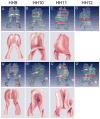Patterning of the heart field in the chick
- PMID: 18513714
- PMCID: PMC2522384
- DOI: 10.1016/j.ydbio.2008.04.014
Patterning of the heart field in the chick
Abstract
In human development, it is postulated based on histological sections, that the cardiogenic mesoderm rotates 180 degrees with the pericardial cavity. This is also thought to be the case in mouse development where gene expression data suggests that the progenitors of the right ventricle and outflow tract invert their position with respect to the progenitors of the atria and left ventricle. However, the inversion in both cases is inferred and has never been shown directly. We have used 3D reconstructions and cell tracing in chick embryos to show that the cardiogenic mesoderm is organized such that the lateralmost cells are incorporated into the cardiac inflow (atria and left ventricle) while medially placed cells are incorporated into the cardiac outflow (right ventricle and outflow tract). This happens because the cardiogenic mesoderm is inverted. The inversion is concomitant with movement of the anterior intestinal portal which rolls caudally to form the foregut pocket. The bilateral cranial cardiogenic fields fold medially and ventrally and fuse. After heart looping the seam made by ventral fusion will become the greater curvature of the heart loop. The caudal border of the cardiogenic mesoderm which ends up dorsally coincides with the inner curvature. Physical ablation of selected areas of the cardiogenic mesoderm based on this new fate map confirmed these results and, in addition, showed that the right and left atria arise from the right and left heart fields. The inversion and the new fate map account for several unexplained observations and provide a unified concept of heart fields and heart tube formation for avians and mammals.
Figures









References
-
- Alsan BH, Schultheiss TM. Regulation of avian cardiogenesis by Fgf8 signaling. Development. 2002;129:1935–1943. - PubMed
-
- Barron M, Gao M, Lough J. Requirement for BMP and FGF signaling during cardiogenic induction in non-precardiac mesoderm is specific, transient, and cooperative. Dev Dyn. 2000;218:383–393. - PubMed
-
- Bruneau BG, Logan M, Davis N, Levi T, Tabin CJ, Seidman JG, Seidman CE. Chamber-specific cardiac expression of Tbx5 and heart defects in Holt-Oram syndrome. Dev Biol. 1999;211:100–108. - PubMed
-
- Buckingham M, Meilhac S, Zaffran S. Building the mammalian heart from two sources of myocardial cells. Nat Rev Genet. 2005;6:826–35. - PubMed
Publication types
MeSH terms
Substances
Grants and funding
LinkOut - more resources
Full Text Sources

